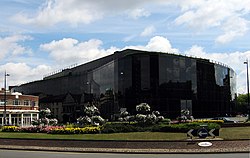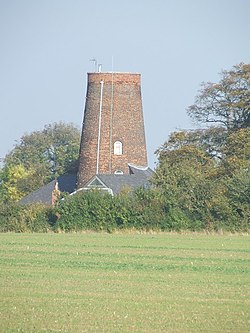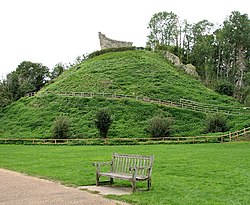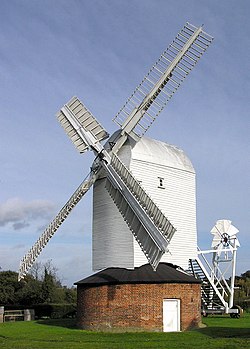| Name | Image | Location | Description |
|---|
| Aldeburgh Martello Tower |  | Aldeburgh | Quatrefoil martello tower, the largest and northernmost of 103 English defensive towers built between 1808 and 1812 to resist a Napoleonic invasion and the only surviving building of the fishing village of Slaughden, which had been washed away by the North Sea by 1936. Grade II* listed building. |
| Bawdsey Manor |  | Bawdsey | Victorian manor house built in 1886 most notable for the role it had to play in the development of radar during the Second World War, during its time as an Air Ministry research station. Grade II* listed building. |
| Burgh Windmill |  | Burgh | Tower mill built in 1842 which has been converted to residential accommodation. Grade II listed building. |
| Buttrum's Mill, Woodbridge |  | Woodbridge | Tower mill built in 1836 which has been restored to working order. Grade II listed building. |
| Fort Green Mill, Aldeburgh | 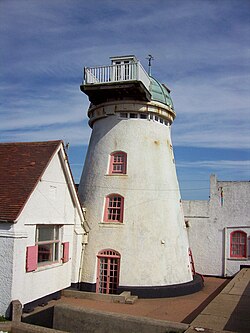 | Aldeburgh | Tower mill built in 1824 which has been converted to residential accommodation. |
| Framlingham Castle | 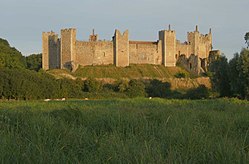 | Framlingham | Medieval castle established in 1148 with a curtain wall, an unusual feature at the time. Grade I listed building. |
| Friston Windmill |  | Friston | Conserved post mill built in 1812. Grade II* listed building. |
| Greyfriars, Dunwich | 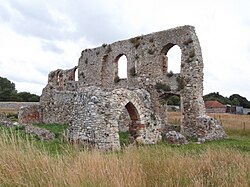 | Dunwich | Ruins of a Franciscan friary founded before 1277, but abandoned in 1289 due to coastal erosion. Grade II* listed building. |
| Havergate Island | 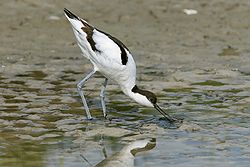 | Orford | The only island in Suffolk and a marshy RSPB nature reserve notable for its populations of avocets and terns. |
| Historic Centre of Dunwich and its Seafront |  | Dunwich | Former capital of the Kingdom of the East Angles, but most of the town has been lost to the sea due to coastal erosion beginning in 1286, events for which it has become famous. The town features the remains of many churches, friaries and a leper hospital. |
| Historic Centre of Felixstowe and its Seafront |  | Felixstowe | Edwardian seaside town and port, the largest container port in the United Kingdom. |
| Historic Centre of Woodbridge and its Seafront |  | Woodbridge, Suffolk | Town with over 1,100 years of recorded history with historic buildings and harbour. |
| House in the Clouds |  | Thorpeness | Water tower built in 1923 with the appearance of a weatherboarded building more in keeping with Thorpeness's mock-Tudor and Jacobean style, except seeming to float above the trees. Grade II listed building. |
| Landguard Fort |  | Felixstowe | Fort built by James I to guard the entrance to Harwich. Grade I listed building. |
| Leiston Abbey |  | Theberton | Ruins of an Augustinian abbey built in 1182 by Ranulf de Glanvill. Grade I listed building. |
| Long Shop Museum |  | Leiston | Industrial museum dedicated to the history of Richard Garrett & Sons who manufactured agricultural machinery, Steam engines and Trolleybuses in Leiston. Grade II* listed building. |
| Orford Castle | 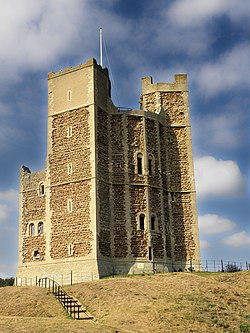 | Orford | Medieval castle with a well-preserved keep, described as 'one of the most remarkable keeps in England', built by Henry II from 1165 to 1173 to consolidate royal power in the region. It is of a unique design and probably based on Byzantine architecture. Grade I listed building. |
| Orford Ness | 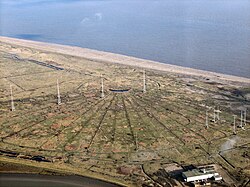 | Orford | Cuspate foreland shingle spit that is an internationally important site for nature conservation, as it contains a significant portion of the European reserve of vegetated shingle habitat, which is internationally scarce, highly fragile and very easily damaged. |
| Orfordness Beacon |  | Orford | Early radio navigation system introduced in July 1929. It allowed the angle to the station to be measured from any aircraft or ship with a conventional radio receiver, and was accurate to about a degree. |
| Orfordness Lighthouse |  | Orford | Lighthouse built in 1792 and decommissioned in 2013. |
| RAF Bentwaters |  | Tunstall | Former Royal Air Force station used by the RAF during the Second World War and United States Air Force during the Cold War. It now forms part of Bentwaters Cold War Museum. |
| RAF Woodbridge | | Woodbridge | Former Royal Air Force military airfield constructed in 1943 to assist damaged aircraft to land on their return from raids over Germany during the Second World War. It was then used by the United States Air Force during the Cold War and split into Woodbridge Airfield and Rock Barracks in 2006. |
| RSPB Minsmere |  | Minsmere | RSPB nature reserve covering areas of reed bed, lowland heath, lowland wet grassland, and shingle vegetation. It has populations of Eurasian bitterns, Western marsh harriers and Pied avocets and is a birdwatching site. |
| Saxtead Green Windmill |  | Saxtead | Restored 18th-century post mill. Grade II* listed building. |
| Skoulding's Mill, Kelsale | 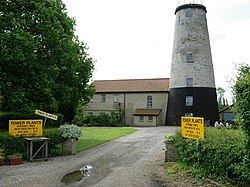 | Kelsale | Tower mill built in 1856 which has been converted to residential accommodation. Grade II listed building. |
| Snape Maltings |  | Snape | Arts complex that is one of the main sites of the annual Aldeburgh Festival originally used for the malting of barley for the brewing of beer. |
| St. Andrew's Church, Bramfield |  | Bramfield, Suffolk | 13th-century Anglican church with the only flint-built detached round tower in Suffolk, which was possibly built as a defensive stronghold for the nearby manor house. Grade I listed building. |
| Suffolk Coast and Heaths |  | Aldeburgh | Area of Outstanding Natural Beauty covering much of the Suffolk coastline, including ancient woodland, shingle beaches, mudflats, reed beds, salt marsh and heathland. |
| Sutton Hoo |  | Woodbridge | Site of two 6th- and early 7th-century cemeteries. One contained an undisturbed ship burial, including a wealth of Anglo-Saxon artefacts of outstanding art-historical and archaeological significance, most of which are now in the British Museum in London. |
| Thorpeness Windmill |  | Thorpeness | Post mill built in 1803 in Aldringham and moved to Thorpeness in 1923. Grade II listed building. |
| Tricker's Mill, Woodbridge |  | Woodbridge | Tower mill built in 1818 which has been incorporated to a sheltered housing scheme. It is the oldest intact tower mill in Suffolk. Grade II listed building. |
| Westwood Marshes Mill, Walberswick |  | Walberswick | Derelict 18th-century tower mill. It is the oldest surviving tower mill in Suffolk. |
| Woodbridge Tide Mill | 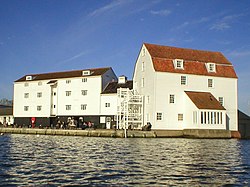 | Woodbridge | Tide mill built c. 1536. It is a rare example of a fully functioning tide mill, whose water wheel is capable of grinding wholemeal flour. Grade I listed building. |
| Blackshore Mill, Reydon |  | Reydon | Conserved tower mill built c. 1890. Grade II listed building. |
| Blundeston Windmill |  | Blundeston | Tower mill built c. 1820 which has been converted to residential accommodation. |
| Bungay Castle |  | Bungay | Ruins of a Norman keep and bailey castle built in 1100 by Roger Bigod of Norfolk. Grade I listed building. |
| Church of Holton St. Peter |  | Holton St. Peter | 11th-century Norman church with the tallest round church tower in the county. Grade II* listed building. |
| Corton Windmill |  | Corton | Tower mill built in 1837 which has been converted to residential accommodation. Grade II listed building. |
| East Anglia Transport Museum | 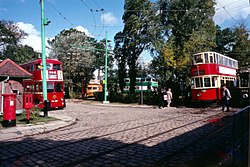 | Lowestoft | Open-air transport museum, with numerous historic public transport vehicles, including many in full working order. |
| Flixton Road Mill, Bungay | 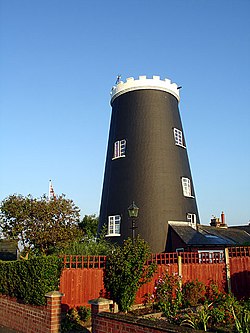 | Bungay | Tower mill built in 1830 which has been truncated and converted to residential accommodation. Grade II listed building. |
| Herringfleet Windmill |  | Herringfleet | Restored smock mill built c. 1820 which has been restored to working order. It is the oldest working smock mill in Suffolk. Grade II* listed building. |
| Historic Centre of Lowestoft and its Seafront |  | Lowestoft | Historic port town, which developed due to the fishing industry, and a traditional seaside resort. It has a long history, some of the earliest evidence of settlement in Britain being found here. It has wide, sandy beaches, two piers and a number of other tourist attractions and historic buildings. |
| Holton Windmill | 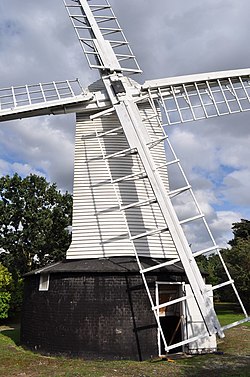 | Holton | Preserved post mill built in 1749. It is the oldest surviving windmill with its sails in Suffolk. Grade II listed building. |
| Lound Windmill |  | Lound, Suffolk | Tower mill built in 1837 which has been converted to residential accommodation. |
| Lowestoft Lighthouse |  | Lowestoft | Lighthouse built in 1874 to give warning of the dangerous sandbanks around the coast. It is one of only two working lighthouses in Suffolk. Grade II listed building. |
| Lowestoft War Memorial Museum |  | Lowestoft | Headquarters of the Royal Naval Patrol Service during the Second World War which now houses a museum dedicated to the effect of the First and Second World Wars. |
| Mettingham Castle |  | Mettingham | Fortified manor house built by Sir John de Norwich in 1342. Grade II listed building. |
| Mincarlo |  | Lowestoft | Last surviving fishing trawler of the Lowestoft fishing fleet and last built in the town. It is now maintained as a museum. |
| Ness Point |  | Lowestoft | The most easterly point in the United Kingdom, marked by a direction marker, known as Euroscope. It is also the location of Britain's tallest wind turbine. |
| Norfolk and Suffolk Aviation Museum |  | Flixton | Museum collection of aircraft and aviation-related artefacts |
| Somerleyton Hall |  | Somerleyton | Country house built in 1604 in Tudor-Jacobean style before being transformed into an Anglo-Italian masterpiece in 1843. Its garden contains a yew hedge maze considered one of the finest in the country. Grade II* listed building. |
| Southwold Lighthouse |  | Southwold | Lighthouse built in 1889. It is one of only two working lighthouses in Suffolk and a prominent local landmark. Grade II listed building. |
| Southwold Pier | 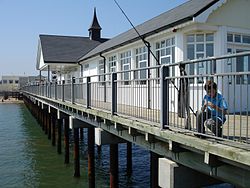 | Southwold | Historic pier built in 1900 that includes a collection of modern coin-operated novelty machines designed by Tim Hunkin. |
| St Andrew's Church, Covehithe | 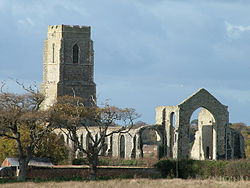 | Covehithe | Redundant Anglican church built in the 17th century within the walls of a larger 14th-century church. Grade I listed building. |
|





















